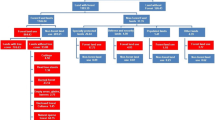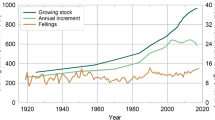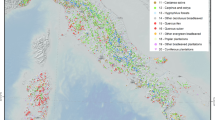Abstract
In the frame of a process aiming at harmonizing National Forest Inventory (NFI) and ICP Forests Level I Forest Condition Monitoring (FCM) in Italy, we investigated (a) the long-term consistency between FCM sample points (a subsample of the first NFI, 1985, NFI_1) and recent forest area estimates (after the second NFI, 2005, NFI_2) and (b) the effect of tree selection method (tree-based or plot-based) on sample composition and defoliation statistics. The two investigations were carried out on 261 and 252 FCM sites, respectively. Results show that some individual forest categories (larch and stone pine, Norway spruce, other coniferous, beech, temperate oaks and cork oak forests) are over-represented and others (hornbeam and hophornbeam, other deciduous broadleaved and holm oak forests) are under-represented in the FCM sample. This is probably due to a change in forest cover, which has increased by 1,559,200 ha from 1985 to 2005. In case of shift from a tree-based to a plot-based selection method, 3,130 (46.7 %) of the original 6,703 sample trees will be abandoned, and 1,473 new trees will be selected. The balance between exclusion of former sample trees and inclusion of new ones will be particularly unfavourable for conifers (with only 16.4 % of excluded trees replaced by new ones) and less for deciduous broadleaves (with 63.5 % of excluded trees replaced). The total number of tree species surveyed will not be impacted, while the number of trees per species will, and the resulting (plot-based) sample composition will have a much larger frequency of deciduous broadleaved trees. The newly selected trees have—in general—smaller diameter at breast height (DBH) and defoliation scores. Given the larger rate of turnover, the deciduous broadleaved part of the sample will be more impacted. Our results suggest that both a revision of FCM network to account for forest area change and a plot-based approach to permit statistical inference and avoid bias in the tree sample composition in terms of DBH (and likely age and structure) are desirable in Italy. As the adoption of a plot-based approach will keep a large share of the trees formerly selected, direct tree-by-tree comparison will remain possible, thus limiting the impact on the time series comparability. In addition, the plot-based design will favour the integration with NFI_2.







Similar content being viewed by others
References
Brassel, P., & Brändli, U.-B. (Eds.). (1999). Schweizerisches Landesforstinventar. Ergebnisse der Zweitaufnahme 1993–1995 (p. 442). Birmensdorf: Eidg. Forschungsanstalt für Wald, Schnee und Landschaft. Bern, Bundesamt für Umwelt, Wald und Landschaft.
Bussotti, F., Gerosa, G., Cenni, E., Cozzi, A., Ferretti, M., Bettini, D., et al. (2003). Crown condition surveys in Italian forests: issues in reporting findings. Environmental Monitoring and Assessment, 85, 221–238.
Bussotti, F., Ferretti, M., Cozzi, A., & Cenni, E. (1999). Condizione delle chiome degli alberi. Valutazione nelle aree permanenti di livello 2—Manuale di Campagna. Rome: Ministero per le Politiche Agricole.
Bussotti, F., Cozzi, A., Cenni, E., Bettini, D., Sarti, C., & Ferretti, M. (2009). Measurement errors in monitoring tree crown conditions: entity, control, evolution and implications for results. Journal of Environmental Monitoring, 11, 769–773.
Cozzi, A., Ferretti, M., & Lorenz, M. (2002). Quality assurance for crown condition assessment in Europe. Geneva: UN/ECE.
Chirici, G., Corona, P., Ferretti, M., Travaglino, D., Fattorini, L., Barbati, A., & Bottalico, F. (2010). The Futmon large-scale forest monitoring grid. Final report of Action C1-harmonLS of the project FutMon (LIFE07 ENV/D/000218). http://www.futmon.org/futmon-results. Accessed 28 Mar 2012.
Cordy, C. B., & Thompson, C. M. (1995). An application of deterministic variogram to design-based variance estimation. Mathematical Geology, 27, 173–205.
Stevens, D. (1994). Implementation of a national monitoring program’. Journal of Environmental Management, 42, 1–29.
Fattorini, L., Marcheselli, M., & Pisani, C. (2006). A three-phase sampling strategy for large-scale multiresource forest inventories. Journal of Agricultural, Biological, and Environmental Statistics, 11, 296–316.
Ferretti, M. (1997). Forest health assessment and monitoring. Issues for consideration. Environmental Monitoring and Assessment, 48, 45–72.
Ferretti, M., Bussotti, F., Cenni, E., & Cozzi, A. (1999). Implementation of quality assurance procedures in the Italian Programs of Forest Condition Monitoring. Water, Air, and Soil Pollution, 116, 371–376.
Ferretti, M., Cherubini, P., Dobbertin, M., Nimis, P. L., & Parr, T.W. (2001). La questione del campionamento nelle reti di monitoraggio degli effetti dell’inquinamento ambientale e dei cambiamenti climatici sulle risorse naturali in Europa—Tra vecchi problemi e nuove necessità. In ISAFA (Ed.), Comunicazioni di Ricerca 2001/2 (pp. 51–72). Trento.
Ferretti, M. (2010). Harmonizing forest inventories and forest condition monitoring—the rise or the fall of harmonized forest condition monitoring in Europe? iForest. doi:10.3832/ifor0518-003.
Ferretti, M., Fischer, R., Mues, V., Granke, O., & Lorenz, M. (2010). Basic design principles for the ICP Forests Monitoring Networks. In Manual (part II) on methods and criteria for harmonized sampling, assessment, monitoring and analysis of the effects of air pollution on forests. Hamburg: UNECE ICP Forests Programme Co-ordinating Centre. ISBN: 978-3-926301-03-1. http://www.icp-forests.org/Manual.htm. Accessed 28 Mar 2012.
Fischer, R., & Lorenz, M. (Eds.). (2011). Forest condition in Europe, 2011 technical report of ICP forests and FutMon. Work report of the institute for world forestry 2011/1. Hamburg: ICP Forests.
Frayer, W. E., & Furnival, G. M. (1999). Forest survey sampling designs: a history. Journal of Forestry, 97(12), 4–8.
Gasparini, P., Bertani, R., De Natale, F., Di Cosmo, L., & Pompei, E. (2009). Quality control procedures in the Italian national forest inventory. Journal of Environmental Monitoring, 11, 761.
Gasparini, P., Tosi, V., & Di Cosmo, L. (2010). Development of the Italian National Forest Inventory. In E. Tomppo, T. Gschwantner, M. Lawrence, & R. E. McRoberts (Eds.), National forest inventories—pathways for common reporting (pp. 311–331). New York: Springer.
INFC (2003). Guida alla classificazione della vegetazione forestale. Trento: CRA-MPF. http://mpf.entecra.it/?q=it/node/1322. Accessed 28 Mar 2012.
INFC (2006). Procedure di posizionamento e di rilievo degli attributi di terza fase (con istruzioni per l’impiego degli applicativi NAV3 e RAS3). Trento: CRA-MPF. http://mpf.entecra.it/?q=it/node/686. Accessed 28 Mar 2012.
Innes, J. L. (1993). Forest health: Its assessment and status. Wallingford: CAB International.
Kleinn, C., & Vilĉko, F. (2006). Design-unbiased estimation for point-to-tree distance sampling. Canadian Journal of Forest Research, 36, 1407–1414.
Lindenmayer, D. B., Likens, G. E., Haywood, A., & Miezis, L. (2011). Adaptive monitoring in the real world: proof of concept. Trends in Ecology & Evolution, 26(12), 641–646.
Lorenz, M. (1995). International co-operative programme on assessment and monitoring of air pollution effects on forests-ICP Forests. Water, Air, and Soil Pollution, 85, 1221–1226.
MAF-ISAFA (1985). IFN-Inventario Forestale Nazionale. Sintesi metodologica e risultati. Altomonte: Ministero dell’Agricoltura e delle Foreste.
Strand, G.-H. (1995). Estimation of the difference in crown vigour for 2280 coniferous trees in Norway from 1989 to 1994, adjusted for the effects of ageing. Environmental Monitoring and Assessment, 36, 61–74.
Mariano, A., Gasparini, P., De Natale, F., Colletti, L., De Macrì, A., Pompei, E., Romano, R., Sambucini, V., Visentin, R., & Vitullo, M. (2010). Global Forest Resources Assessment 2010. Country report, Italy, FRA2010/202. http://www.fao.org/docrep/013/al537E/al537E.pdf. Accessed 28 Mar 2012.
Tomppo, E., Gschwantner Th., Lawrence, M., & McRoberts, R.E. (Eds.) (2010). National Forest Inventories—pathways for common reporting. New York: Springer.
Thorell, K. E., & Ostlin, E. O. (1931). The national forest survey of Sweden. Journal of Forestry, 4, 585–591.
Travaglini, D., Fattorini, L., Barbati, A., Bottalico, F., Corona, P., Ferretti, M., et al. (2012). Towards a sampling strategy for the assessment of forest condition at European level: combining country estimates. Environmental Monitoring and Assessment. doi:10.1007/s10661-012-2788-5. Online First™, 3 August 2012. With kind permission from Springer Science+Business Media.
UN-ECE. (1998). Manual on methodologies and criteria for harmonized sampling, assessment, monitoring and analysis of the effects on air pollution on forests. Hamburg: Programme Coordinating Centres.
Wulff, S., Lindelöw, Å., Lundin, L., Hansson, P., Axelsson, A. L., Barklund, P., et al. (2011). Adapting forest health assessments to changing perspectives on threats—a case example from Sweden. Environmental Monitoring and Assessment. doi:10.1007/s10661-011-2130-7.
Acknowledgments
The study was funded by the Project “FutMon” (LIFE 07 ENV/D/00218). We thank the personnel of the National Forest Service for the data collection and all the colleagues who helped with the training and the data entry. We are also grateful to the referees, whose suggestions considerably helped to improve the article.
Author information
Authors and Affiliations
Corresponding author
Rights and permissions
About this article
Cite this article
Gasparini, P., Di Cosmo, L., Cenni, E. et al. Towards the harmonization between National Forest Inventory and Forest Condition Monitoring. Consistency of plot allocation and effect of tree selection methods on sample statistics in Italy. Environ Monit Assess 185, 6155–6171 (2013). https://doi.org/10.1007/s10661-012-3014-1
Received:
Accepted:
Published:
Issue Date:
DOI: https://doi.org/10.1007/s10661-012-3014-1




